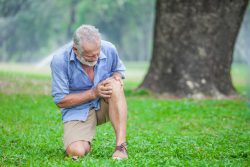
Researchers at the Georgia Institute of Technology have engineered a molecular matrix which will deliver stem cells referred to as muscle satellite cells (MuSCs), directly to muscle tissue in patients such as the elderly whose muscles don’t regenerate very well. This molecular matrix, a hydrogel, has successfully delivered MuSCs to injured, aged muscles in mice. The hydrogel boosted the healing process while also protecting the stem cells from any harsh immune reactions.
The development has provided a new method by which an aging patient after a car accident for instance, can receive treatment to severe muscle injuries that won’t typically heal. Previously, muscle stem cells from a donor have not been able to be successfully delivered to restore damaged tissue. Simply injecting additional MuSCs into the inflamed, damaged tissue was inefficient. This was mostly due to the stem cells encountering an immune system on the warpath.
Muscle injuries attract immune cells and typically this would help with muscle stem cell repair. However, in the aged or dystropic muscles, immune cells will lead to the release of toxic chemicals such as cytokines and free radicals which kill the new stem cells. Young Jang, one of the researchers says that only about 1 and 20 percent of injected MuSCs actually make it to damaged tissue and those that do will arrive in a weakened state. Additionally, some tissue damage makes any injection unfeasible.
The new hydrogel will protect the cells which will multiply and thrive inside the matrix. The hydrogel is applied to the injured muscles with the cells engrafting onto the tissues which will help them heal. Hydrogels very often start out as a water-based solution of molecular components which resemble crosses and other components that make the ends of the crosses attach to each other. When these components come together, they will fuse into molecular nets suspended in water. This results in a material that resembles the consistency of a gel.
If stem cells are mixed into the solution, when the matrix forms it ensnares the treatment for delivery and also protects the payload from dissipation or death in the body. Researchers can custom engineer hydrogels and can reliably and easily synthesize them by tweaking their components. This physically traps the MuSCs in a net and the cells also grab onto chemical latches that have been engineered into the net or matrix.
The hydrogel’s added latches bond with proteins protruding from stem cells membranes and not only increase the cell’s adhesion to the net, but also hinder them from suicide. Stem cells will tend to kill themselves when they are detached and free floating.
The cells and chemical components are mixed in solution then applied to the muscle that has been injured. The mixture sets to a matrix gel patch which glues the stem cells in place. The gel is biodegradable and biocompatible. The stem cells thrive and multiply in the gel once it has been applied. The hydrogel then degrades and leaves behind the cells engrafted onto muscle tissue in much the same way natural stem cells would be.
In healthier, younger individuals MuSCs are part of the natural healing mechanism in the body. MuSCs are resident stem cells found in the skeletal muscles. They are key players in producing new muscle tissue and live on muscle strands like specks.
As people age they lose muscle mass and the number of satellite cells will also decrease. The ones that do remain get weaker. At very advanced age, a person stops regenerating muscle altogether.
With the new system the researchers engineered, donor cells can be introduced to enhance the repair mechanism in older, injured people. If the new method goes to clinical trials, researchers will most likely have to work around the possibility for donor cell rejection in human patients.
To view the original scientific study click here: Synthetic matrix enhances transplanted satellite cell engraftment in dystrophic and aged skeletal muscle with comorbid trauma





